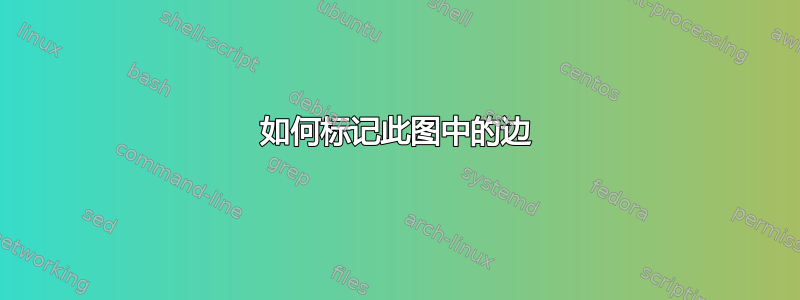
我需要将此图中的边标记为 $a,b,c,..$。请帮我
\documentclass{standalone}
\usepackage{tikz}
\begin{document}
\newlength{\R}\setlength{\R}{3.5cm}
\begin{tikzpicture}[bullet/.style={circle, fill, minimum size=2pt,
inner sep=2pt, outer sep=0pt},nodes=bullet]
\node (circ1) at (45:\R) [bullet,label=right:$1$] {};
\node (circ2) at (90:\R) [bullet,label=above:$2$] {};
\node (circ3) at (135:\R) [bullet,label=left:$3$] {};
\node (circ4) at (180:\R) [bullet,label=left:$4$] {};
\node (circ5) at (225:\R) [bullet,label=left:$5$] {};
\node (circ6) at (270:\R) [bullet,label=below:$6$] {};
\node (circ7) at (315:\R) [bullet,label=right:$7$] {};
\node (circ8) at (360:\R) [bullet,label=right:$0$] {};
\draw [thick] (circ1) to (circ2) to (circ3)
to (circ4) to (circ5) to (circ6) to (circ7)to (circ8) to (circ1)to (circ3) to (circ5) to (circ7) to (circ1) to (circ4) to(circ7) to(circ2) to (circ5) to(circ8) to (circ3) to (circ6);
\draw [thick] (circ1) to (circ5);
\draw [thick] (circ1) to (circ6);
\draw [thick] (circ3) to (circ7);
\end{tikzpicture}
\end {document}
答案1
以下是 Jes 建议的简化代码的尝试,使用一个 foreach 循环绘制代码,并建议如何按字母顺序标记代码。我希望您能实现这个目标。如果我误解了什么,请见谅。
\documentclass[border=3.5mm]{standalone}
\usepackage{tikz}
\pgfdeclarelayer{bg}
\pgfsetlayers{bg,main}
\begin{document}
\begin{tikzpicture}
%nodes and labels
\foreach\x/\y/\z in {0/0/A,2.5/-1/B,5/0/C,6/2.5/D,5/5/E,2.5/6/F,0/5/G,-1/2.5/H}
\draw [] (\x,\y) circle (1 mm) node[fill=white,draw=black,circle,inner sep=1pt] {\z};
%draw star
\begin{pgfonlayer}{bg}
\draw[red ] (0,0)
\foreach \x/\y/\z in {5/0,5/5,0/5,0/0/A,5/5,2.5/-1,0/5,5/0,2.5/6,0/0,6/2.5,0/5,5/0,-1/2.5,5/5,6/2.5,5/0,2.5/-1,0/0,-1/2.5,0/5,2.5/6,5/5}
{-- (\x,\y)
};
\end{pgfonlayer}
\end{tikzpicture}
\end{document}
编辑:好的,另一个带有标记边缘的版本。这更符合您的要求吗?
EDIT2:一个更吸引人的版本。注意:使用\behind path节点参数可以使线条连续。
\documentclass[border=3.5mm]{standalone}
\usepackage{tikz}
\pgfdeclarelayer{bg}
\pgfsetlayers{bg,main}
\begin{document}
\begin{tikzpicture}
\foreach\x/\y/\z in {0/0/1,2.5/-1/2,5/0/3,6/2.5/4,5/5/5,2.5/6/6,0/5/7,-1/2.5/8}
\draw [] (\x,\y) circle (1 mm) node[fill=white,draw=black,circle,inner sep=1pt] {\z};
\begin{pgfonlayer}{bg}
\draw[red ] (0,0)
\foreach \x/\y/\z in {
5/0/A,
5/5/B,
0/5/C,
0/0/D,
5/5/E,
2.5/-1/F,
0/5/G,
5/0/EH,
2.5/6/I,
0/0/J,
6/2.5/K,
0/5/L,
5/0/EH,
-1/2.5/M,
5/5/N,
6/2.5/O,
5/0/P,
2.5/-1/Q,
0/0/R,
-1/2.5/S,
0/5/T,
2.5/6/U,
5/5/V
}
{-- (\x,\y) node [midway,above, fill=white,circle, text=black,inner sep=0pt,yshift=2pt,behind path] {\tiny\z}
};
\end{pgfonlayer}
\end{tikzpicture}
\end{document}
没有\behind path:
和\behind path:
答案2
绘制图形的一种方法:
\documentclass[border=3.141592]{standalone}
\usepackage{tikz}
\usetikzlibrary{quotes}
\begin{document}
\newlength{\R}\setlength{\R}{3.5cm}
\begin{tikzpicture}[
dot/.style = {circle, fill, outer sep=0pt, auto=right},
every edge quotes/.style = {rounded corners=2pt, fill=white, font=\footnotesize, inner sep=0.5pt}
]
\foreach \i [count=\j] in {45,90,...,360}%
{\node (c\j) [dot, label=\i:\j] at (\i:\R) {};}
\foreach \i [count=\j, count=\k from 2] in {a,b,...,h}%
{
\ifnum\j<8
\draw[thick] (c\j) to ["\i", auto=right] (c\k);
\else
\draw[thick] (c\j) to ["\i", auto=right] (c1);
\fi
}
\foreach \i [count=\j from 3] in {i,j,...,m} % 5
\draw[semithick,gray] (c1) to[pos=0.1,"\i"] (c\j);
\foreach \i [count=\j from 4] in {n,o,...,r} % 5
\draw[semithick,gray] (c2) to[pos=0.1,"\i"] (c\j);
\foreach \i [count=\j from 5] in {s,t,u,v} % 4
\draw[semithick,gray] (c3) to[pos=0.1,"\i"] (c\j);
\foreach \i [count=\j from 6] in {x,y,z} % 3
\draw[semithick,gray] (c4) to[pos=0.1,"\i"] (c\j);
\foreach \i [count=\j from 7] in {?,??} % 2
\draw[semithick,gray] (c5) to[pos=0.1,"\i"] (c\j);
\draw[semithick,gray] (c6) to[pos=0.1,"???"] (c8);
\end{tikzpicture}
\end{document}
然而,正如你所看到的,它的边比字母表中的字母还多。此外,标签是如何分布的还不得而知:







